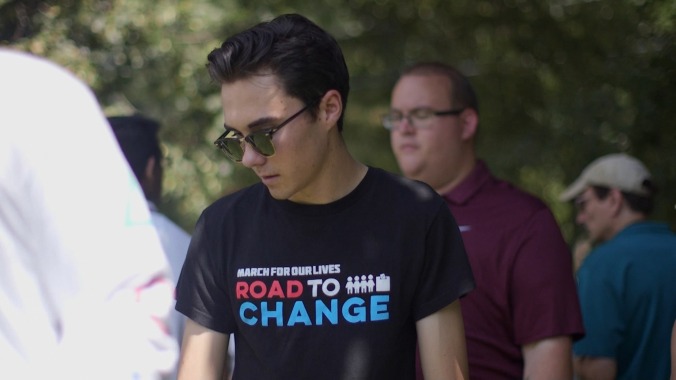For much of the past decade, millions of schoolchildren across the United States have had to spend part of their class time at the beginning of each year running “active shooter drills,” learning how to duck and hide if a heavily armed gunman ever storms their campus. Meanwhile, their parents—who grew up in a world where the only “drills” required in school were for fires and maybe tornadoes or hurricanes—hear about what their kids did that day and silently steal a glance at the calendar, counting down the years until their youngsters can graduate and get out of harm’s way. This has become the new normal in America.
After Parkland’s directors, Jake Lefferman and Emily Taguchi, began making their film not long after the incident, and mostly use their own interviews and original footage (mixed with some news clips) to tell the story of a handful of students and loved ones who’ve tried to find useful ways to cope with their grief, while living in the national spotlight. The film documents a trip to the White House, an event with the governor of Florida, the reopening of Marjory Stoneman Douglas, and several big rallies and protests—including a well-publicized nationwide school walkout and the March For Our Lives. But Lefferman and Taguchi also take the time to capture smaller moments: a basketball game, a formal dance, a quiet snack in an inviting suburban kitchen. The idea is to emphasize the normalcy that the shooting disrupted, which the people most affected by it are struggling to reclaim.
The most well-known After Parkland subject is David Hogg, a survivor who has drawn the ire of second amendment advocates for his TV news appearances and social media posts stumping for gun control. Hogg has one of the most haunting lines in his interviews with the filmmakers, when he says of returning to class, “Imagine being in a plane crash, surviving, and then getting in the same plane every day.” Hogg also seems the most committed to making what happened to him and his classmates into the tipping point toward real change—even when his worried mom would rather he log off Twitter and get a good night’s sleep.
But the film’s most fascinating figure is Andrew Pollack, the father of one of the murdered students. Unconvinced (at least at the start of After Parkland) that teenagers making righteously furious speeches about guns will have any effect, Pollack instead pushes for improved school security, finding it much easier to get conservative Florida politicians to back those proposals. But Pollack’s early victories prove less satisfying than he’d hoped, and the relative resilience of the teenagers in the community only end up reminding him of what he’s lost.
As is sometimes the case with documentaries made quickly after a major national news story, After Parkland feels a little incomplete. The intensity and intimacy of the interviews and the slice-of-life scenes are so remarkable that it’s easy to understand why Lefferman and Taguchi wanted to get their movie out into the world right away. This story is still unfolding, and the conventional wisdom about what the shooting will mean for the future of guns in America is still in flux. This documentary might’ve been better with another few years’ worth of reporting and perspective.
That’s a minor complaint, though, about a film that on the whole is both riveting and relevant. The point of focusing on Hogg and Pollack—along with about about a half-dozen other very different people—is to show that while the reactions to the shooting within Parkland have been varied, they’ve all been infused with some degree of frustrated ire. If nothing else, this has become one of the rare cases where in the wake of a senseless slaughter, the focus has been more on the victims and the survivors than on the killer. In a subtle but insistent way, After Parkland suggests that this simple act of changing the narrative around an appalling act of violence—rather than just learning to live with it—could be the way to prevent it from happening again.



 Keep scrolling for more great stories from A.V. Club.
Keep scrolling for more great stories from A.V. Club.